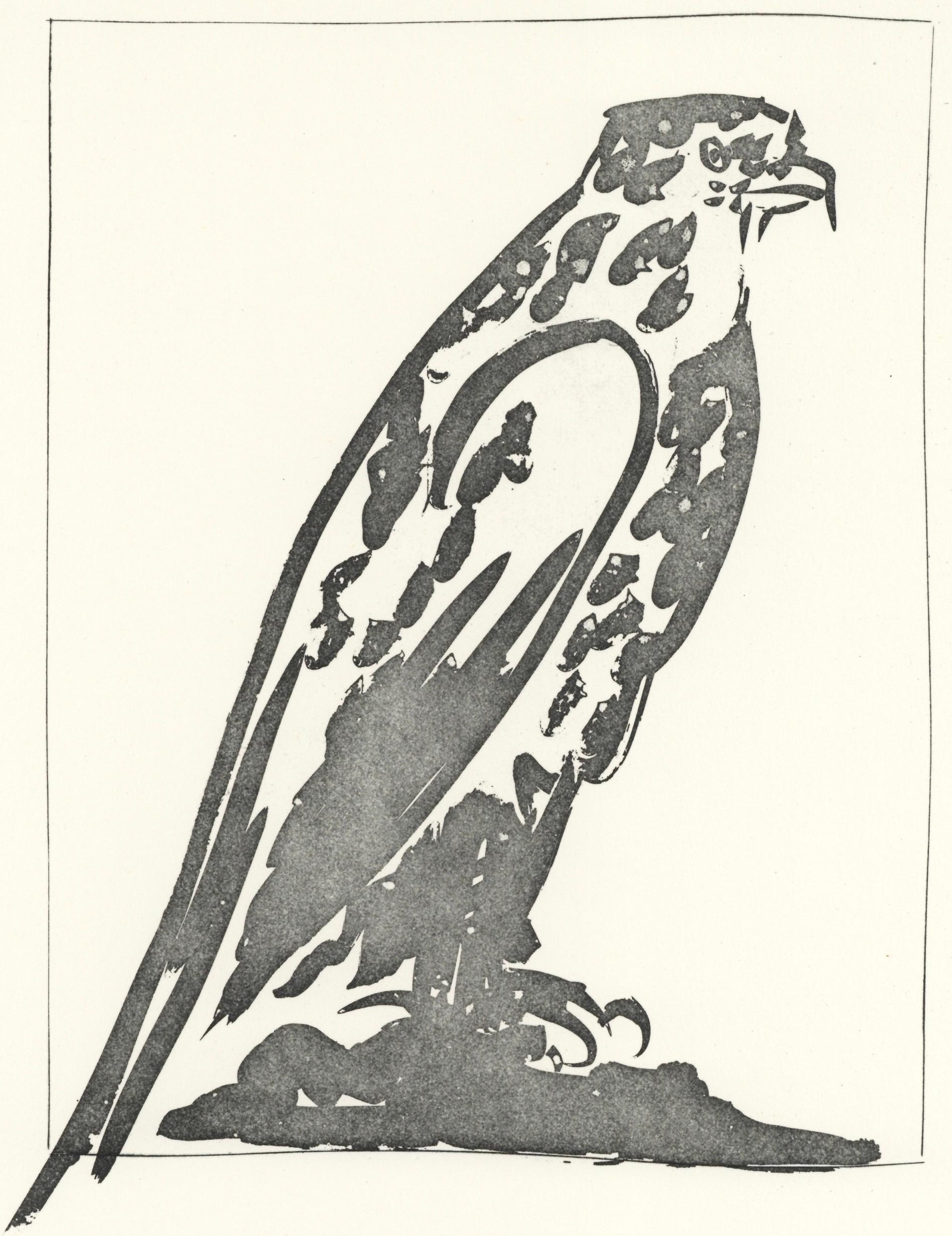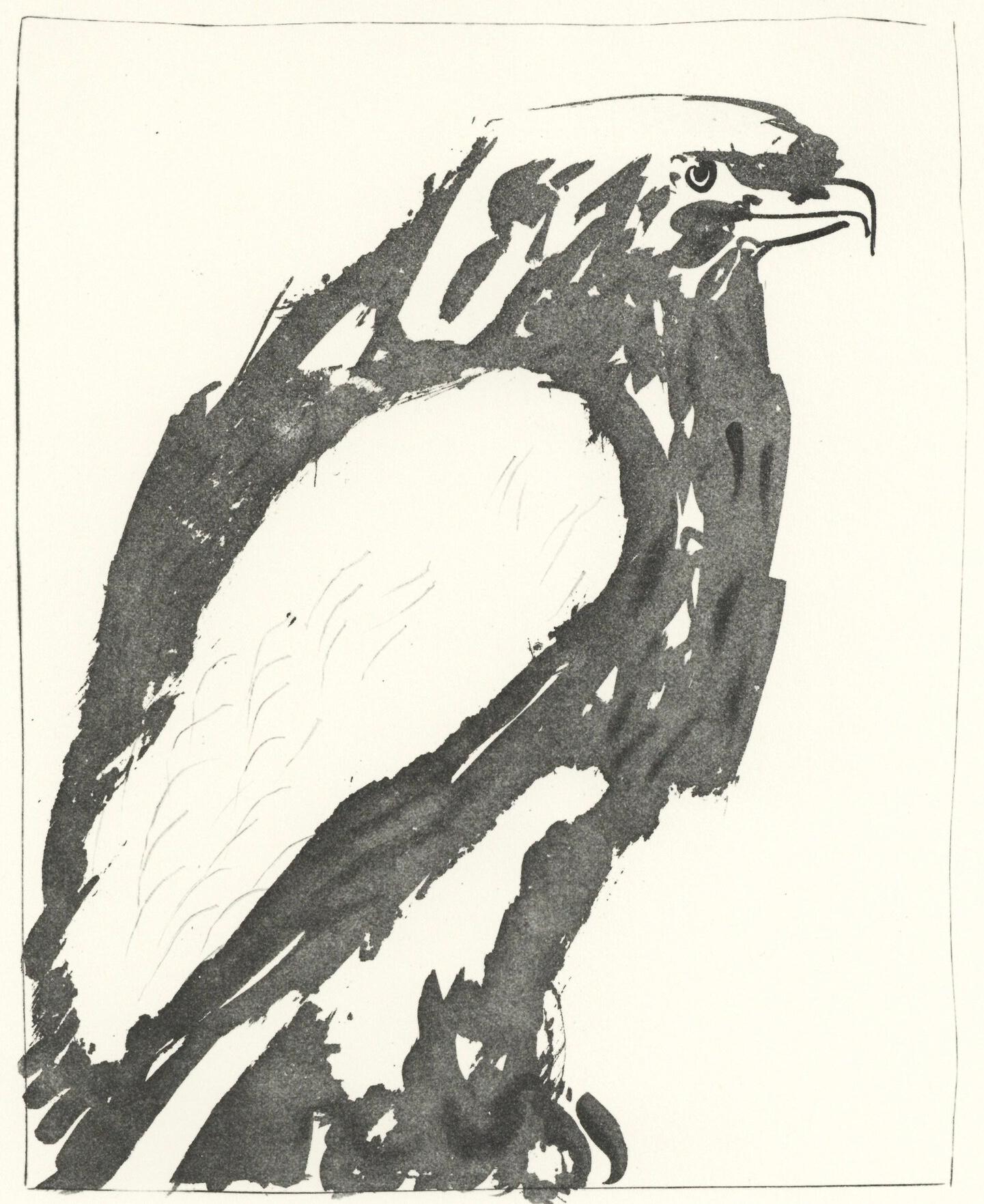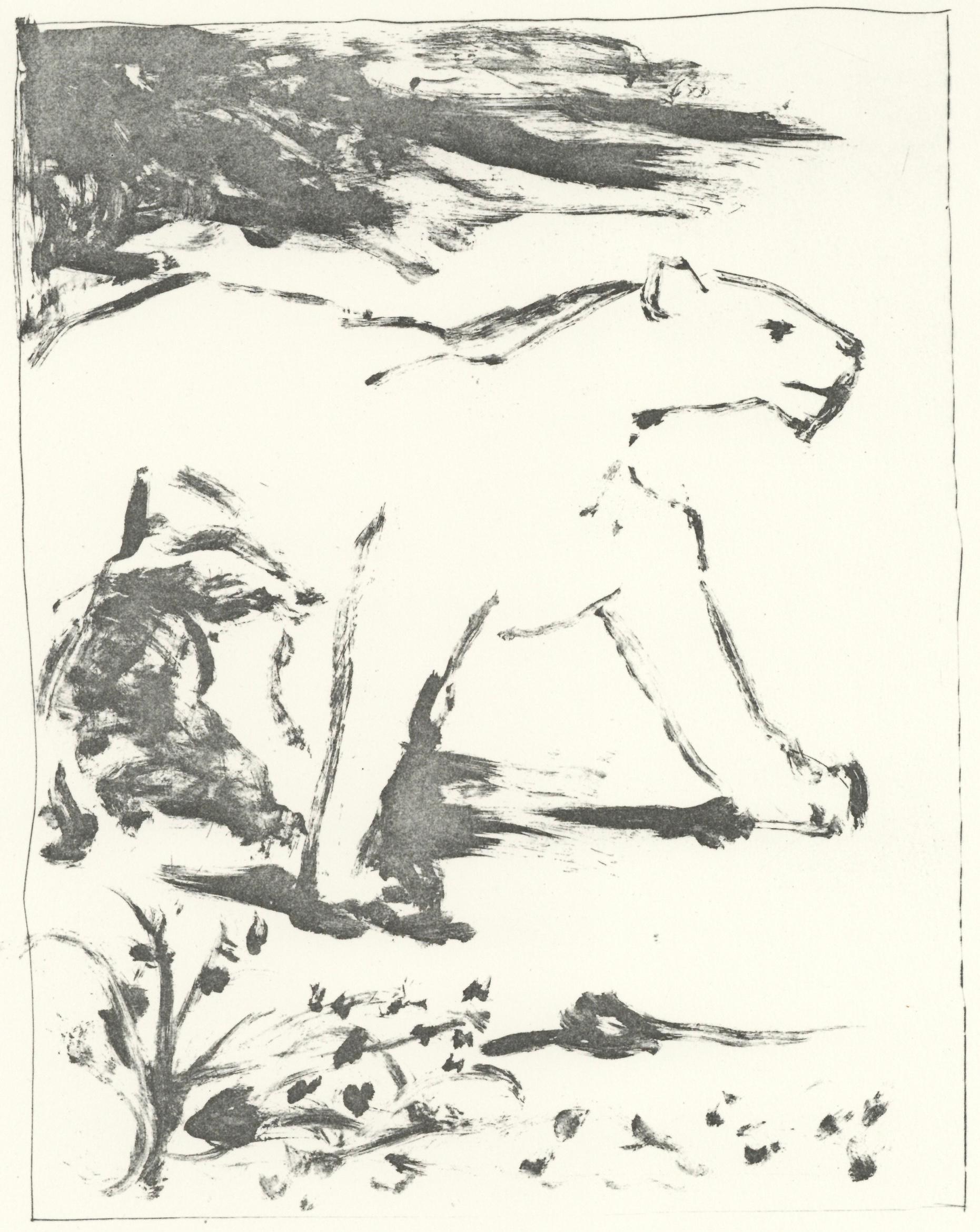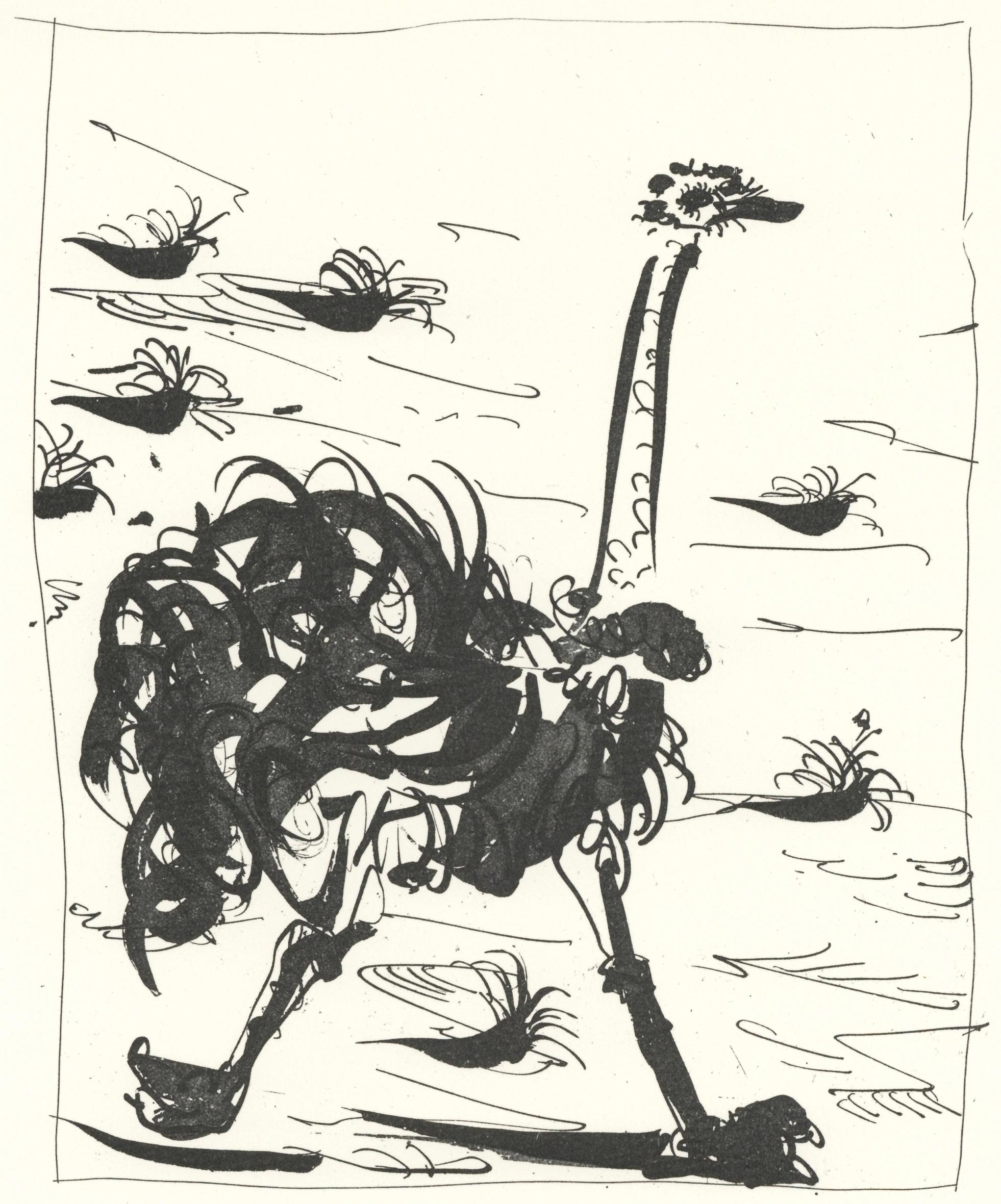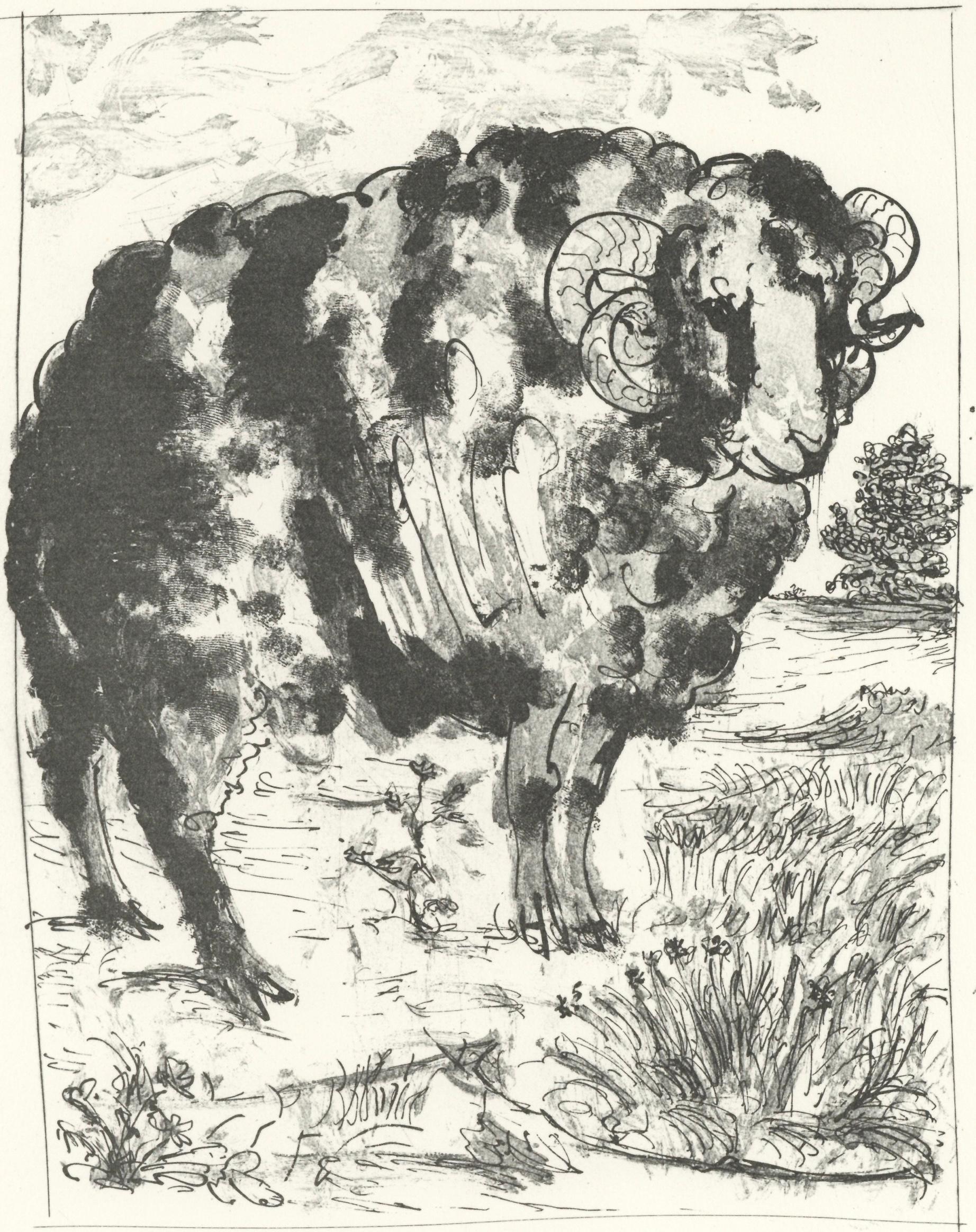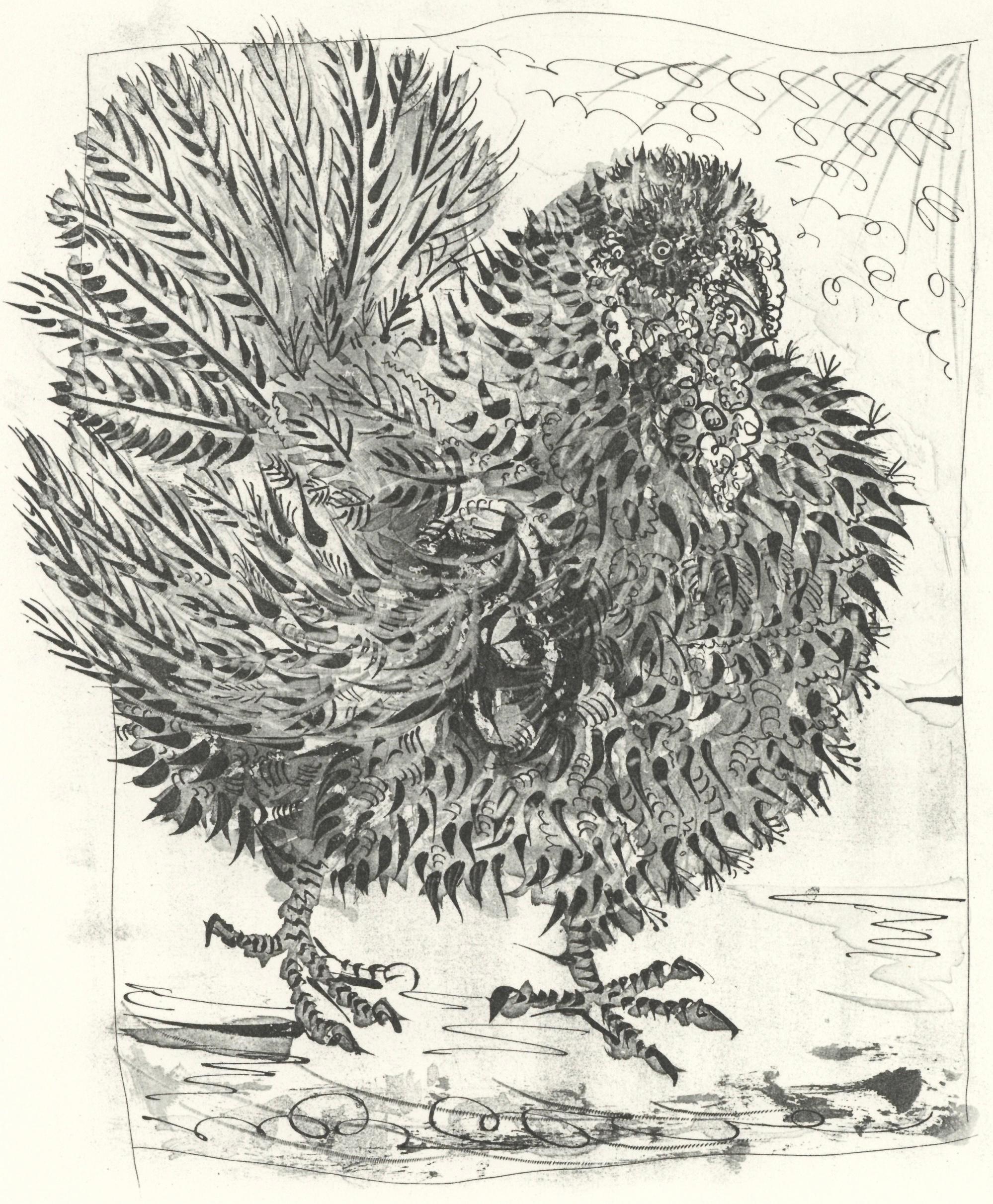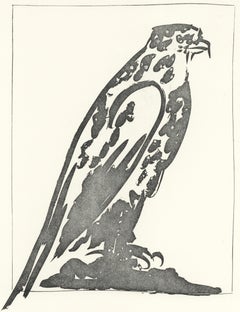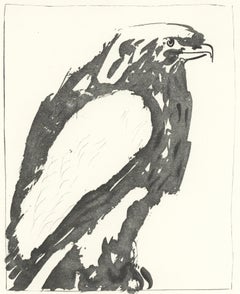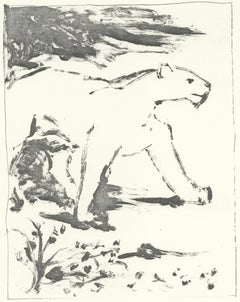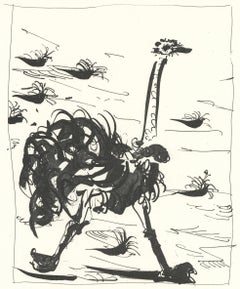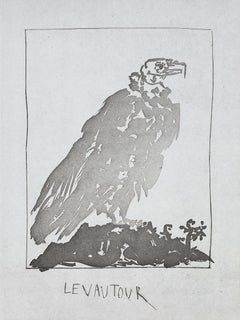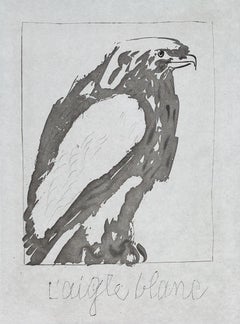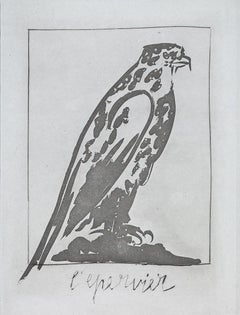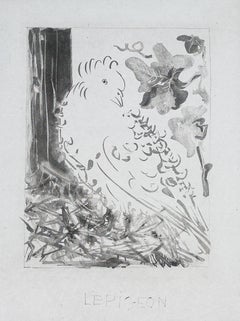Items Similar to Pablo Picasso, The Vulture, from Histoire naturelle, 1970 (after)
Want more images or videos?
Request additional images or videos from the seller
1 of 11
Pablo Picasso, The Vulture, from Histoire naturelle, 1970 (after)1970
1970
$626.50
$89530% Off
£475.93
£679.9030% Off
€548.19
€783.1330% Off
CA$896.27
CA$1,280.3930% Off
A$982.97
A$1,404.2530% Off
CHF 506.96
CHF 724.2330% Off
MX$11,742.43
MX$16,774.9030% Off
NOK 6,429.79
NOK 9,185.4230% Off
SEK 6,031.87
SEK 8,616.9630% Off
DKK 4,095.42
DKK 5,850.5930% Off
About the Item
This exquisite lithograph after Pablo Picasso (1881–1973), titled Le Vautour (The Vulture), originates from the rare 1970 folio Pablo Picasso, Histoire naturelle (Natural History). Published and printed by Production Edito-Service S.A., Le Grand-Saconnex, Canton of Geneve, this remarkable project presents a second edition of a suite of images created by Picasso to accompany the classic natural history texts of Georges-Louis Leclerc, Comte de Buffon. First conceived in 1936 and realized over several decades, these works reflect Picasso’s fascination with nature, movement, and organic form, reinterpreting Buffon’s 18th-century scientific prose through the lens of modern art.
Executed on papier bouffant des Papeteries de Casteljoux paper, this lithograph measures 12.99 x 9.84 inches (33 x 25 cm). As issued, it is unsigned and unnumbered, consistent with the authorized 1970 publication format. This edition, produced with the permission of Martin Fabiani, preserves the integrity, tonality, and clarity of Picasso’s original etchings from the celebrated 1942 edition, reaffirming his mastery of line and form.
Artwork Details:
Artist: After Pablo Picasso (1881–1973)
Title: Le Vautour (The Vulture), from Pablo Picasso, Histoire naturelle (Natural History), 1970
Medium: Lithograph on papier bouffant des Papeteries de Casteljoux paper
Dimensions: Paper size 12.99 x 9.84 inches (33 x 25 cm)
Inscription: Unsigned and unnumbered, as issued
Date: 1970 (after the 1942 original etchings)
Publisher: Production Edito-Service S.A., Le Grand-Saconnex, Canton of Geneve
Printer: Production Edito-Service S.A., Le Grand-Saconnex, Canton of Geneve and Italy
Condition: Well preserved, consistent with age and medium
Provenance: From the 1970 folio Pablo Picasso, Histoire naturelle (Natural History), published by Production Edito-Service S.A., Le Grand-Saconnex, Canton of Geneve
Notes:
Excerpted from the folio (translated from French), Picasso, eaux-fortes originales pour des textes de Buffon. At the expense and care of Martin Fabiani, this book was completed to be printed in paris on may XXVI MCM XLII. Pablo Picasso's original XXXI eaux-fortes were drawn by R. Lacourière and the printing of texts by M. Fequet and P. Baudier. Justification of the draw. CCXXVI examples. N°1. — single example on papier vergé Ancien with a suite on papier Ancien bleuté; II to VI. V examples on Japon Super—Nacré with a sequel on Chine; VII to XXXVI. XXX examples on Japon Impérial with a suite on Chine; XXXVII to XCI. LV examples on vélin of Montval; XCII to CCXXVI. CXXXV examples on vélin de Vidalon. This second edition, 25 x 33 cm, was created with the permission of Martin Fabiani, publisher in Paris, on papier bouffant des Papeteries de Casteljoux.
About the Artist:
Pablo Picasso (1881–1973) was a Spanish painter, sculptor, printmaker, and ceramicist whose revolutionary vision redefined modern art in the 20th century. Born in Malaga, Spain, he demonstrated prodigious talent from an early age and trained in Barcelona and Madrid before moving to Paris, where he became the epicenter of avant-garde innovation. Picasso pioneered Cubism alongside Georges Braque, explored emotional depth through his Blue and Rose periods, and continually reinvented his style across thousands of works in painting, drawing, sculpture, and printmaking. His influence spans movements from Surrealism to abstraction, and his work remains central to global art history. The highest price ever paid for one of his artworks is approximately US $179.4 million for Les Femmes d'Alger (Version O) (1955).
Pablo Picasso lithograph, Picasso Le Vautour (The Vulture), Picasso Histoire naturelle (Natural History), Picasso Buffon, Picasso Fabiani edition, Picasso 1970 edition, Picasso Roger Lacouriere printer, Picasso Edito-Service Geneve, Picasso natural history etchings, Picasso illustration suite, Picasso 1942 Buffon series, Picasso art book, Picasso French modern art, Picasso collectible lithograph, Picasso 20th century edition, Picasso modernist print, Picasso animal studies, Picasso Paris publication.
- Creation Year:1970
- Dimensions:Height: 12.99 in (33 cm)Width: 9.84 in (25 cm)
- Medium:
- Movement & Style:
- After:Pablo Picasso (1881-1973, Spanish)
- Period:
- Condition:
- Gallery Location:Southampton, NY
- Reference Number:1stDibs: LU1465214809552
About the Seller
4.9
Platinum Seller
Premium sellers with a 4.7+ rating and 24-hour response times
Established in 1978
1stDibs seller since 2021
1,199 sales on 1stDibs
Typical response time: <1 hour
- ShippingRetrieving quote...Shipping from: Southampton, NY
- Return Policy
Authenticity Guarantee
In the unlikely event there’s an issue with an item’s authenticity, contact us within 1 year for a full refund. DetailsMoney-Back Guarantee
If your item is not as described, is damaged in transit, or does not arrive, contact us within 7 days for a full refund. Details24-Hour Cancellation
You have a 24-hour grace period in which to reconsider your purchase, with no questions asked.Vetted Professional Sellers
Our world-class sellers must adhere to strict standards for service and quality, maintaining the integrity of our listings.Price-Match Guarantee
If you find that a seller listed the same item for a lower price elsewhere, we’ll match it.Trusted Global Delivery
Our best-in-class carrier network provides specialized shipping options worldwide, including custom delivery.More From This Seller
View AllPablo Picasso, The Hawk, from Histoire naturelle, 1970 (after)
By Pablo Picasso
Located in Southampton, NY
This exquisite lithograph after Pablo Picasso (1881–1973), titled L'Epervier (The Sparrowhawk), originates from the rare 1970 folio Pablo Picasso, Histoire naturelle (Natural History...
Category
1970s Cubist Animal Prints
Materials
Lithograph
$626 Sale Price
42% Off
Free Shipping
Pablo Picasso, The Eagle, from Histoire naturelle, 1970 (after)
By Pablo Picasso
Located in Southampton, NY
This exquisite lithograph after Pablo Picasso (1881–1973), titled L'Aigle (The Eagle), originates from the rare 1970 folio Pablo Picasso, Histoire naturelle (Natural History). Publis...
Category
1970s Cubist Animal Prints
Materials
Lithograph
$626 Sale Price
42% Off
Free Shipping
Pablo Picasso, The Lioness, from Histoire naturelle, 1970 (after)
By Pablo Picasso
Located in Southampton, NY
This exquisite lithograph after Pablo Picasso (1881–1973), titled La Lionne (The Lioness), originates from the rare 1970 folio Pablo Picasso, Histoire naturelle (Natural History). Pu...
Category
1970s Cubist Animal Prints
Materials
Lithograph
$626 Sale Price
42% Off
Free Shipping
Pablo Picasso, The Ostrich, from Histoire naturelle, 1970 (after)
By Pablo Picasso
Located in Southampton, NY
This exquisite lithograph after Pablo Picasso (1881–1973), titled L'Autruche (The Ostrich), originates from the rare 1970 folio Pablo Picasso, Histoire naturelle (Natural History). P...
Category
1970s Cubist Animal Prints
Materials
Lithograph
$626 Sale Price
30% Off
Free Shipping
Pablo Picasso, The Ram, from Histoire naturelle, 1970 (after)
By Pablo Picasso
Located in Southampton, NY
This exquisite lithograph after Pablo Picasso (1881–1973), titled Le Belier (The Ram), originates from the rare 1970 folio Pablo Picasso, Histoire naturelle (Natural History). Publis...
Category
1970s Cubist Animal Prints
Materials
Lithograph
$626 Sale Price
47% Off
Free Shipping
Pablo Picasso, The Turkey, from Histoire naturelle, 1970 (after)
By Pablo Picasso
Located in Southampton, NY
This exquisite lithograph after Pablo Picasso (1881–1973), titled Le Dindon (The Turkey), originates from the rare 1970 folio Pablo Picasso, Histoire naturelle (Natural History). Pub...
Category
1970s Cubist Animal Prints
Materials
Lithograph
$626 Sale Price
47% Off
Free Shipping
You May Also Like
The Vulture. 1942 (Histoire Naturelle - Textes de Buffon, B.341)
By Pablo Picasso
Located in Greenwich, CT
The Vulture is an aquatint and drypoint print on chine from one of the deluxe copies of Picasso's 1942 Histoire Naturelle - Textes de Buffon series. The image size is 10.6 x 8 inches, unsigned as issued, and framed in a contemporary silver and gray moulding. One of about 36 prints that exist with Picasso's remarqued title in French, from the edition of 262 (there were 226 portfolios, some with additional sets on varying papers).
Catalogue - Cramer #37
The exceptional etchings from Picasso’s Histoire Naturelle – Textes de Buffon are a masterful combination of sugar-lift aquatint and drypoint, showcasing a full range of gray tonalities. The etchings of animals, birds and insects are considered some of the most beautiful and most unusual examples of Picasso’s graphic work.
Roger Lacourière, Picasso’s master printer, pulled the prints for each etching between 1939-1942. It was Lacourière who taught Picasso the sugar-lift aquatint technique which allowed him to mimic the effect of brushstrokes in these etched images. Picasso first explored the technique in his plates for the Vollard Suite, but it was in the creation of the Buffon images that he fully realized its stunning, painterly potential.
For the edition, 226 portfolios were produced with the first thirty-six counting as deluxe compilations. These rare deluxe sets were on diverse papers (chine, japon or vergé ancien) and each included a complete additional suite showing Picasso’s title remarques along the bottom. As such, the remarqued versions of the prints are quite rare with just thirty-six of each produced for the edition (with the exception of The Wolf which is never remarqued – the image always fills the entire etching plate).
These prints are based on the writings of French naturalist Georges-Louis Leclerc, Comte de Buffon, who extensively documented the natural world in his monumental work Histoire Naturelle. Picasso’s association with the project to illustrate parts of the Buffon came during a tumultuous time in European history – the prelude to, and early years of, World War II. As the continent was ravaged, Picasso lived through the disaster in Paris, which the Germans occupied in 1940. These prints could be seen as a political statement – Picasso channeling his artistic expression into a form of resistance art...
Category
20th Century Modern Prints and Multiples
Materials
Drypoint, Aquatint
The White Eagle, 1942 (Histoire Naturelle - Textes de Buffon, B.340)
By Pablo Picasso
Located in Greenwich, CT
The White Eagle is an aquatint and drypoint print on chine from one of the deluxe copies of Picasso's 1942 Histoire Naturelle - Textes de Buffon series. The image size is 10.5 x 8.15 inches, unsigned as issued, and framed in a contemporary silver and gray moulding. One of about 36 prints that exist with Picasso's remarqued title in French, from the edition of 262 (there were 226 portfolios, some with additional sets on varying papers).
Catalogue - Cramer #37
The exceptional etchings from Picasso’s Histoire Naturelle – Textes de Buffon are a masterful combination of sugar-lift aquatint and drypoint, showcasing a full range of gray tonalities. The etchings of animals, birds and insects are considered some of the most beautiful and most unusual examples of Picasso’s graphic work.
Roger Lacourière, Picasso’s master printer, pulled the prints for each etching between 1939-1942. It was Lacourière who taught Picasso the sugar-lift aquatint technique which allowed him to mimic the effect of brushstrokes in these etched images. Picasso first explored the technique in his plates for the Vollard Suite, but it was in the creation of the Buffon images that he fully realized its stunning, painterly potential.
For the edition, 226 portfolios were produced with the first thirty-six counting as deluxe compilations. These rare deluxe sets were on diverse papers (chine, japon or vergé ancien) and each included a complete additional suite showing Picasso’s title remarques along the bottom. As such, the remarqued versions of the prints are quite rare with just thirty-six of each produced for the edition (with the exception of The Wolf which is never remarqued – the image always fills the entire etching plate).
These prints are based on the writings of French naturalist Georges-Louis Leclerc, Comte de Buffon, who extensively documented the natural world in his monumental work Histoire Naturelle. Picasso’s association with the project to illustrate parts of the Buffon came during a tumultuous time in European history – the prelude to, and early years of, World War II. As the continent was ravaged, Picasso lived through the disaster in Paris, which the Germans occupied in 1940. These prints could be seen as a political statement – Picasso channeling his artistic expression into a form of resistance art...
Category
20th Century Modern Prints and Multiples
Materials
Drypoint, Aquatint
The Sparrow Hawk, 1942 (Histoire Naturelle - Textes de Buffon, B.342)
By Pablo Picasso
Located in Greenwich, CT
The Sparrow Hawk is an aquatint and drypoint print on chine from one of the deluxe copies of Picasso's 1942 Histoire Naturelle - Textes de Buffon series. The image size is 10.5 x 8 inches, unsigned as issued, and framed in a contemporary silver and gray moulding. One of about 36 prints that exist with Picasso's remarqued title in French, from the edition of 262 (there were 226 portfolios, some with additional sets on varying papers).
Catalogue - Cramer #37
The exceptional etchings from Picasso’s Histoire Naturelle – Textes de Buffon are a masterful combination of sugar-lift aquatint and drypoint, showcasing a full range of gray tonalities. The etchings of animals, birds and insects are considered some of the most beautiful and most unusual examples of Picasso’s graphic work.
Roger Lacourière, Picasso’s master printer, pulled the prints for each etching between 1939-1942. It was Lacourière who taught Picasso the sugar-lift aquatint technique which allowed him to mimic the effect of brushstrokes in these etched images. Picasso first explored the technique in his plates for the Vollard Suite, but it was in the creation of the Buffon images that he fully realized its stunning, painterly potential.
For the edition, 226 portfolios were produced with the first thirty-six counting as deluxe compilations. These rare deluxe sets were on diverse papers (chine, japon or vergé ancien) and each included a complete additional suite showing Picasso’s title remarques along the bottom. As such, the remarqued versions of the prints are quite rare with just thirty-six of each produced for the edition (with the exception of The Wolf which is never remarqued – the image always fills the entire etching plate).
These prints are based on the writings of French naturalist Georges-Louis Leclerc, Comte de Buffon, who extensively documented the natural world in his monumental work Histoire Naturelle. Picasso’s association with the project to illustrate parts of the Buffon came during a tumultuous time in European history – the prelude to, and early years of, World War II. As the continent was ravaged, Picasso lived through the disaster in Paris, which the Germans occupied in 1940. These prints could be seen as a political statement – Picasso channeling his artistic expression into a form of resistance art...
Category
20th Century Modern Prints and Multiples
Materials
Drypoint, Aquatint
The Pigeon, 1942 (Histoire Naturelle - Textes de Buffon, B.347)
By Pablo Picasso
Located in Greenwich, CT
The Pigeon is an aquatint and drypoint print on chine from one of the deluxe copies of Picasso's 1942 Histoire Naturelle - Textes de Buffon series. The image size is 10.75x 8 inches, unsigned as issued, and framed in a contemporary silver and gray moulding. One of about 36 prints that exist with Picasso's remarqued title in French, from the edition of 262 (there were 226 portfolios, some with additional sets on varying papers).
Catalogue - Cramer #37
The exceptional etchings from Picasso’s Histoire Naturelle – Textes de Buffon are a masterful combination of sugar-lift aquatint and drypoint, showcasing a full range of gray tonalities. The etchings of animals, birds and insects are considered some of the most beautiful and most unusual examples of Picasso’s graphic work.
Roger Lacourière, Picasso’s master printer, pulled the prints for each etching between 1939-1942. It was Lacourière who taught Picasso the sugar-lift aquatint technique which allowed him to mimic the effect of brushstrokes in these etched images. Picasso first explored the technique in his plates for the Vollard Suite, but it was in the creation of the Buffon images that he fully realized its stunning, painterly potential.
For the edition, 226 portfolios were produced with the first thirty-six counting as deluxe compilations. These rare deluxe sets were on diverse papers (chine, japon or vergé ancien) and each included a complete additional suite showing Picasso’s title remarques along the bottom. As such, the remarqued versions of the prints are quite rare with just thirty-six of each produced for the edition (with the exception of The Wolf which is never remarqued – the image always fills the entire etching plate).
These prints are based on the writings of French naturalist Georges-Louis Leclerc, Comte de Buffon, who extensively documented the natural world in his monumental work Histoire Naturelle. Picasso’s association with the project to illustrate parts of the Buffon came during a tumultuous time in European history – the prelude to, and early years of, World War II. As the continent was ravaged, Picasso lived through the disaster in Paris, which the Germans occupied in 1940. These prints could be seen as a political statement – Picasso channeling his artistic expression into a form of resistance art...
Category
20th Century Modern Prints and Multiples
Materials
Drypoint, Aquatint
Bird - Original Woodcut - Early 20th Century
Located in Roma, IT
Bird is an original woodcut realized by an artist of the early 20th Century.
The artwork is in very good conditions and mounted on a white cardboard passpartout (49x34).
Artist’s i...
Category
Early 20th Century Animal Prints
Materials
Paper, Woodcut
Picasso, Minotaure blesse VI (after)
By Pablo Picasso
Located in Fairfield, CT
Artist: After Pablo Picasso (1881-1973)
Title: Minotaure blesse VI (Bloch 196)
Year: 1992
Medium: Reproduced from the original edition using the grain Autotype halftone screen process by Druck- und Verlag GmbH, 4200 Oberhausen, Germany; lithographically printed by Druck- und Verlag GmbH on japon handmade 200 g/sqm paper by created by Richard de Bas in Ambert, France and imported by Japico Drissler Feinpapiere, Frankfurt, Germany.
Paper Size: 18 x 12.75 inches; a size slightly reduced from the original Vollard edition for differentiation
Condition: Excellent
Inscription: Artist’s signature posthumously lithographically reproduced from the original Vollard edition, and numbered in pencil by the curators of the Municipal Museum Mülheim an der Ruhr, Germany. 168/300.
Notes: Published by Municipal Museum Mülheim an der Ruhr, Germany in cooperation with the Society for the Promotion of the museum in 1992 and the Fundación Picasso; printed by Plitt Druck- und Verlag GmbH, 4200 Oberhausen, Germany. The following is a German to English translation of the original text issued by the Municipal Museum Mülheim an der Ruhr, Germany in the following from which this graphic is a part, “In order to give a broad public access to this unique print work by Pablo Picasso in its entirety and at the highest quality level, the support group for the city. Museum Mülheim an der Ruhr initiated and significantly supported the new edition of the “Suite Vollard.” The reprint of the "Suite Vollard" includes a limited edition of 300 copies of 100 loose sheets each in a linen cassette. The copies were numbered from 1 to 300 on the leader sheet. The reproductions were produced in grain screen mode, a process in which which eliminates the traditional line grid and achieves maximum originality. The paper was hand-made specifically for this work by Richard de Bas in Ambert, France, one of the most traditional paper mills in Europe. The paper for the original edition also comes from this factory. The quality Blane narcisse, belin, 200 g/sqm was selected and imported from Japico Drissler Feinpapiere, Frankfurt. Reproduction and paper format has been slightly reduced compared to the original edition. The technical development and overall production was carried out by Plitt Druck- und Verlag GmbH, 4200 Oberhausen.”
PABLO PICASSO (1881-1973) Spanish painter and sculptor is one of the most recognized figures of twentieth century art. During his artistic career, which lasted more than 75 years, he created thousands of works using all kinds of mediums. He changed art more profoundly than any other artist of his time. First famous for pioneering cubism...
Category
1990s Cubist Nude Prints
Materials
Lithograph
$3,400 Sale Price
20% Off
More Ways To Browse
Picasso Etching Vollard Suite
Picasso Les Dejeuners
Picasso Lithograph 1974
Picasso Silkscreen
Polo Antiques
Pop And Scott
Punk Original
R C Gorman Originals
Rene Magritte Poster
Retro Library Posters
Reynolds Etching
Richard Lane
Robert Conover
Robert Von Neumann
Ruth Gleaning
Salvador Dali Bullfight
Salvador Dali Color Etching
Salvador Dali Flower
